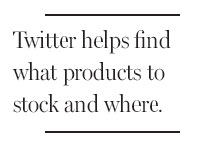Social media give a view of buyers
Updated: 2012-08-13 13:19
By Stephanie Clifford (The New York Times) (The New York Times)
|
|||||||||||
 |
|
The Frito-Lay Do Us a Flavor contest on the company's Facebook app allows users to suggest and vote on flavors, giving the company data. |
Frito-Lay is developing a new potato chip flavor, which, in the old days, would have involved a series of focus groups, research and trend analysis.
Now, it uses Facebook.
Visitors to the new Lay's Facebook app are asked to suggest new flavors and click an "I'd Eat That" button to register their preferences. So far, the results show that a beer-battered onion-ring flavor is popular in California and Ohio, while a churros flavor is a hit in New York.
Frito-Lay has run the contest outside the United States, resulting in chip flavors like hot and spicy crab in Thailand and pickled cucumber in Serbia.
"It's a new way of getting consumer research," said Ann Mukherjee, chief marketing officer of Frito-Lay North America. "We're going to get a ton of new ideas."
Companies like Wal-Mart and Samuel Adams are turning social media sites into extensions of market research departments. And companies are just beginning to figure out how to use the huge amount of information available.
When Wal-Mart wanted to know whether to stock lollipop-shaped cake makers in its stores, it studied Twitter. Estee Lauder's MAC Cosmetics brand asked social media users to vote on which discontinued shades to bring back. The stuffed-animal brand Squishable solicited Facebook feedback before settling on the final version of a new toy. And Samuel Adams asked users to vote on yeast, hops, color and other qualities to create a crowdsourced beer that got rave reviews.
"It tells us exactly what customers are interested in," said Elizabeth Francis, chief marketing officer of the Gilt Groupe, a shopping Web site. Gilt asks customers to vote on products to include in sales, and sets up Facebook chats between engineers and customers to help refine products. "It's amazing that we can get that kind of real feedback, as opposed to speculating," Ms. Francis said.
Wal-Mart acquired the social media company Kosmix last year for an estimated $300 million, chiefly because of Kosmix's ability to extract trends from social media conversations.
The unit, now called @WalmartLabs, looks at Twitter posts, public Facebook posts and search terms on Walmart.com, among other cues, to help Wal-Mart refine what it sells. Its technology can identify the context of words, distinguishing "Salt," the Angelina Jolie movie, from salt, the seasoning, for example. It sets baselines for what a normal level of excitement around, say, electronics or toys is, so it can measure when interest is getting high. It also analyzes sentiment, because if people overwhelmingly dislike a new video game, ordering pallets of the game is not a great bet.
"There's mountains and mountains of data being created in social media," said Ravi Raj, vice president for products for @WalmartLabs.
Related Stories
Fashionable media group 2012-05-15 14:54
Youku looks inward for growth in original media 2012-04-25 18:09
GLAAD Media Awards 2012-04-23 17:30
Media a hot topic 2012-03-29 10:39
Mobiles and media innovation 2012-03-20 17:43
Today's Top News
Rescuers race against time for quake victims
Telecom workers restore links
Coal mine blast kills 18 in Jilin
Intl scholarship puts China on the map
More bird flu patients discharged
Gold loses sheen, but still a safe bet
US 'turns blind eye to human rights'
Telecom workers restore links
Hot Topics
Lunar probe , China growth forecasts, Emission rules get tougher, China seen through 'colored lens', International board,
Editor's Picks

|

|

|

|

|

|






